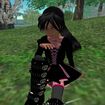Difference between revisions of "User:Lum Pfohl/SL Trivia"
Jump to navigation
Jump to search
m (→SL Trivia) |
m |
||
| Line 16: | Line 16: | ||
# '''It is possible to hide your group affiliation from your profile.''' There is a setting in your GROUP INFO dialog box which will keep the group from appearing there. The group will still appear in your MY GROUPS display, so you can activate / administer it at anytime. | # '''It is possible to hide your group affiliation from your profile.''' There is a setting in your GROUP INFO dialog box which will keep the group from appearing there. The group will still appear in your MY GROUPS display, so you can activate / administer it at anytime. | ||
# '''It is possible to zoom into an Avatar's head.''' Inside, you'll see eyeballs, teeth and a tougue! Here's how. Using your Camera Controls, focus your camera on your face. Then, press and hold ALT and the Left Mouse Button and move the mouse forward. You'll break right past the face until you are peering inside your own head. Normally, your avatar does not emote so these teeth and tongue are not shown. When I zoomed into my head, I was dismayed to discover I had no brain... My friend Dahlia Trimble once thought of putting an animated squirrel in a wheel and embedding that into the Avatar's head. | # '''It is possible to zoom into an Avatar's head.''' Inside, you'll see eyeballs, teeth and a tougue! Here's how. Using your Camera Controls, focus your camera on your face. Then, press and hold ALT and the Left Mouse Button and move the mouse forward. You'll break right past the face until you are peering inside your own head. Normally, your avatar does not emote so these teeth and tongue are not shown. When I zoomed into my head, I was dismayed to discover I had no brain... My friend Dahlia Trimble once thought of putting an animated squirrel in a wheel and embedding that into the Avatar's head. | ||
# '''An avatar's rendition during ''Normal'' and ''Appearances'' is different.''' This is difficult to describe, so please stick with me. When we view each other on our screens, the textures that we see of each other might be coming from different sources between Normal SL activity and while the other Resident is in Appearances mode. When everything is OK and not broken, Normal SL and Appearances doesn't seem to differ (except that we turn gray momentarily when we come out of Appearances). But the difference is '''very apparent''' when a Resident is afflicted with the blackened skin or disappearing clothing. While they are in Appearances mode, their skin and clothing look correct. When they come out, it's as though some OTHER texture loads, and their skin turns black, or their skirt disappears again | # '''An avatar's rendition during ''Normal'' and ''Appearances'' is different.''' This is difficult to describe, so please stick with me. When we view each other on our screens, the textures that we see of each other might be coming from different sources between Normal SL activity and while the other Resident is in Appearances mode. When everything is OK and not broken, Normal SL and Appearances doesn't seem to differ (except that we turn gray momentarily when we come out of Appearances). But the difference is '''very apparent''' when a Resident is afflicted with the blackened skin or disappearing clothing. While they are in Appearances mode, their skin and clothing look correct. When they come out, it's as though some OTHER texture loads, and their skin turns black, or their skirt disappears again. | ||
# '''An avatar's skin and clothing can be influenced by the condition of the Resident's computer.''' Again consider the Resident who has blackened skin. He's black on HIS screen, and he's black on YOUR screen. No matter what he puts on, it's black. You give hime YOUR clothing to wear, and he TURNS IT BLACK when he wears it. Following the [[User:Lum Pfohl/Troubleshooting#Blackened Avatar|Troubleshooting]] steps, the very same clothing's appearances can be made to look normal again. It's the same clothing in the Asset Server as before. The only thing different is what the Resident did on their computer - and everything looks normal to everyone again. This | # '''An avatar's skin and clothing can be influenced by the condition of the Resident's computer.''' Again consider the Resident who has blackened skin. He's black on HIS screen, and he's black on YOUR screen. No matter what he puts on, it's black. You give hime YOUR clothing to wear, and he TURNS IT BLACK when he wears it. Following the [[User:Lum Pfohl/Troubleshooting#Blackened Avatar|Troubleshooting]] steps, the very same clothing's appearances can be made to look normal again. It's the same clothing in the Asset Server as before. The only thing different is what the Resident did on their computer - and everything looks normal to everyone again. | ||
# '''An avatar's outfit and skin can be affected by wrong textures, even if they run on SLEEK.''' This makes no sense - but it does. So which machine actually serves up the skin and clothing textures? | |||
Revision as of 08:06, 24 January 2008
SL TriviaThese are things I've noticed about SL over the course of a year. In no particular order at this time:
Lum Pfohl 06:55, 29 November 2007 (PST) |
|
